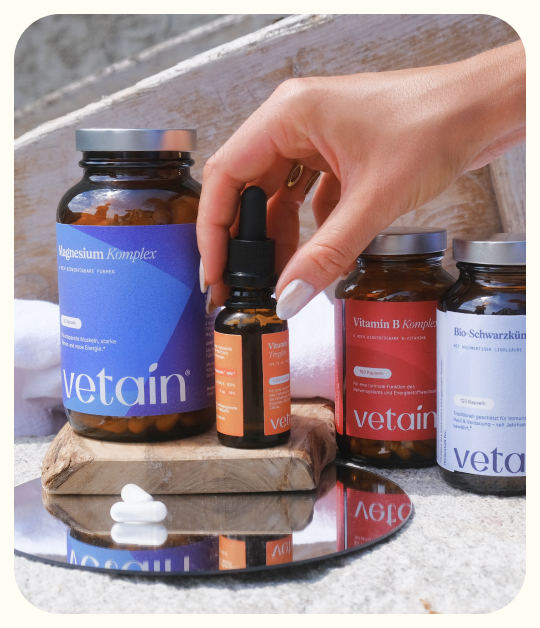Vitamin C is probably the best-known vitamin of them all. But have you ever thought about how much vitamin C you actually need per day? In this article, we take a look at your daily vitamin C requirement and show you how to meet it easily.
We’ll also explain how a vitamin C overdose can happen and how to avoid it.
Your quick take: daily vitamin C requirement
Vitamin C has many important functions in the body, such as normal collagen formation and reducing tiredness — so adequate intake really matters.
Fruit and vegetables are rich in vitamin C. The “5-a-day” rule helps you get enough vitamin C.
Women (19+) need about 95 mg of vitamin C per day, men (19+) about 110 mg.
Pregnant and breastfeeding people and smokers have different reference values.
Supplements can help adults meet their daily vitamin C needs.
What is vitamin C?
Vitamin C is — surprise — a vitamin that plays a big role in our diet. It’s water-soluble and also called ascorbic acid.
What does vitamin C do in our body?
Vitamin C contributes…
to normal function of the immune system
to the reduction of tiredness and fatigue
to normal collagen formation for normal function of bones, teeth, skin, and cartilage
to normal energy metabolism
to normal function of the nervous system
to normal psychological function
… among other things.
These effects are why many people pay attention to their vitamin C intake — and some use supplements to ensure they meet their daily needs.
So how much vitamin C per day do you actually need? Let’s take a closer look:
Daily vitamin C requirement
What’s the daily requirement? There isn’t a one-size-fits-all number — it varies by sex, life stage, and more.
In short: women (19+) need about 95 mg/day; men (19+) about 110 mg/day.

Children and adolescents have different, age-based values (see e.g., DGE).
Burning question: Why is the requirement higher for smokers? Vitamin C, as an antioxidant, neutralizes free radicals — and smokers have more of them. Vitamin C has more work to do, so more is needed.
Back to the table: 95 or even 155 mg might sound like a lot — but what does that look like in foods?
Where is vitamin C found? | Top 12 vitamin C foods
Many people think of lemons and oranges. But some foods contain even more vitamin C.
In general, fruit and vegetables lead the way — here are our favorites.
Table: foods high in vitamin C

The catch: Personally, I don’t eat nettles or rosehips every day — and sea buckthorn isn’t a regular either.
So how do you meet your needs with “everyday” foods?
Example:
Morning: a glass of water with the juice of one lemon (~50 ml) → 25 mg vitamin C
100 g tomatoes as a lunch salad → 25 mg
Afternoon snack: a handful of blackcurrants (~50 g) → 88 mg
That’s over 120 mg vitamin C — enough to cover the daily requirement for men and women. Many processed foods also contain added vitamin C.
Important: tomatoes, spinach & co. aren’t “bad” sources just because they have less vitamin C than, say, rosehips. You usually eat them in larger amounts, so they’re excellent contributors. A half pepper is more likely than a handful of nettles. Stick to the “5-a-day” rule — five servings of fruit and veg — and you’re often good to go.
Extra tips:
Vitamin C content varies by season, storage, cooking, etc. Prepare foods gently (raw or lightly steamed rather than long frying).
Vitamin C and iron are best friends: vitamin C increases absorption of plant-based iron. Spinach is a great combo of vitamin C and iron!
You can also get vitamin C via juices or smoothies — some C is lost during prep, but if it helps you consume more, it’s worth it.
- Supplements can be interesting for some!
%-product_content-%
How much vitamin C is in …?
We now know how much we need — and how to meet it. Let’s answer a few FAQs:
Which vegetables have the most vitamin C?
Red bell pepper is a top source. Kale, broccoli, and spinach are also good.Which fruits have the most vitamin C?
Acerola cherry is famous; more common options include blackcurrants, kiwis, and strawberries.How much vitamin C is in a lemon?
About 50 mg.Does an apple contain vitamin C?
Yes — roughly 10–20 mg per apple, depending on variety and size.How much sauerkraut covers the daily requirement?
About half a kilo.Does bell pepper contain vitamin C?
Yes! One red pepper can already cover your daily need.Is a kiwi high in vitamin C?
Yes, around 70–90 mg.
Vitamin C supplementation
True vitamin C deficiency is fortunately rare in countries like Germany. Even if many people don’t always reach five servings of fruit and veg, intake is often sufficient because vitamin C is added to many products. Still, many choose to supplement with vitamin C to be on the safe side.
Vitamin C supplements come in various forms: tablets, capsules, or powders to mix — often with a lemon flavor. In special cases, a vitamin C infusion can be considered.
Follow the product’s directions for use. For many products: take your supplement with plenty of water (or a tasty clear shake).
%-split_content-%
You can take it with or without a meal — whichever you prefer. If you also take iron, you can combine the two. When to take vitamin C is up to you; many like it in the morning as part of their routine.
Can you overdose on vitamin C?
Short answer: yes — like most things in life, there can be too much.
Long answer: it’s possible but uncommon to overdo vitamin C via food. If you eat two large red peppers, you’ll exceed your daily requirement. Such “overages” usually aren’t dramatic because excess, being water-soluble, is excreted. It’s different with supplements: if you exceed the label dose, you can suddenly take in A LOT more — potentially causing nausea or stomach upset until it’s excreted. Always follow the instructions.
Conclusion
Vitamin C is one of the most important vitamins for our bodies, and fruit & veg can help you meet your daily needs. Men need 110 mg/day; women 95 mg/day. Values differ for pregnancy, breastfeeding, and smokers. Vitamin C is especially important during breastfeeding, pregnancy, and times of high physical stress.
Questions? Feel free to email me — I’d love to hear from you! :)
The information in this article does not replace personalized medical or nutritional advice.
Literature
Bundesinstitut für Risikobewertung (BfR). (o.J.). Vitamin C. Je mehr, desto besser?
DGE (2015). Ausgewählte Fragen und Antworten zu Vitamin C.
DGE (o. J.). Vitamin C. https://www.dge.de/wissenschaft/referenzwerte/vitamin-c/















 6 Min
6 Min
 Zuletzt aktualisiert am 03.11.2025
Zuletzt aktualisiert am 03.11.2025



